7 Ways To Help Kids Cope with Anxiety
https://www.pexels.com/photo/desperate-screaming-young-boy-6624327/
Do you remember the first time you felt anxious? How old were you? It might have been when you were a young adult or first went away to college. Unfortunately, with the rise of technology, social media, school shootings, and violence, anxiety levels in children and teens have also been rising steadily. In fact, over 7% of our nation’s kids ages 3 to 17 have been diagnosed with anxiety.
Dr. Hassan Alzein of Alzein Pediatrics in Evergreen Park and Oak Lawn in Illinois has spoken to many of their patient parents about how to recognize anxiety in children. “Anxiety in children can be crippling. It impacts their ability to focus in school, make friends, and participate in extra-curricular activities.
Kids with anxiety feel more isolated and depressed as their chances for success worsen,” he says. “It’s important to give anxious children the tools to cope with these feelings in a healthy way as soon as possible to prevent problems from escalating.”
Symptoms of anxiety are similar in both adults and children and may present in these ways:
- Redoing tasks repeatedly until they reach perfection
- Lack of confidence
- Striving for approval
- Requiring reassurance about performance
- Frequent physical complaints such as stomachaches or headaches
- Avoiding school or other social situations
“Parents should be aware that younger children don’t usually have the language to tell you “I feel anxious about my school performance” and teens may feel embarrassed by these feelings. Instead, they might say “My stomach hurts and I don’t think I should go to school today,” says Dr. Alzein.
These symptoms shouldn’t be ignored. Talk to your pediatrician if you notice one or more of these behaviors. Once it’s established that your child is dealing with anxiety, it’s important to talk openly about it and then teach them coping mechanisms they can practice at home, at school, and in social situations. Dr. Alzein recommends seven different mechanisms as a starting point to teach children about anxiety and how to handle it.
1. Help them recognize the feeling.
Your child has probably heard the words for emotions like “happy,” “sad,” “angry,” or “frustrated.” Has your child heard the word “anxiety” or “anxious?” Chances are, they haven’t. They know they are feeling something but might not have the vocabulary to express themselves.
Parents can help their children by asking them questions about how they are feeling based on what they are able to observe. Questions that Dr. Alzein gives as examples are:
“I see you’re starting to fidget a lot, what are you thinking about?”
“You seem to be avoiding your friends lately, what happened the last time you were at their house?”
“It’s been a month since Grandpa’s funeral. I can tell you miss him.”
By applying tangible examples to a feeling, both you and your child may be able to better understand the cause of anxiety and the symptoms related to it.
2. Teach deep breathing exercises
Once the causes of the anxiety are identified, your child can begin learning how to cope with the feelings. The most common way to cope with feelings of stress and anxiety is with deep breathing exercises. Teach your child that, when they become anxious, to close their eyes and take three deep breaths.
Breathe in through the nose slowly, picture their lungs filling completely, and then breathe out through the mouth slowly. It may help to breathe in for 5 counts, hold for 3 counts and exhale for 5 counts each time. By taking this break, your child takes time to calm their body and therefore calm their mind.
3. Read books about emotions
 https://www.pexels.com/photo/photo-of-girl-reading-book-3755707/
https://www.pexels.com/photo/photo-of-girl-reading-book-3755707/
Children love books and there are kid-friendly books about nearly every positive and negative emotion. Stories about problems, such as bullying, not winning the race or conflicts at home help give children a point of reference for situations they may be experiencing. These stories help put words to emotions. They also provide potential solutions. These stories will point out that problems get easier to carry once kids speak to a trusted adult about what they are feeling.
4. Lead by example.
Even when you don’t think they are, your children are watching you. They are watching how you speak to cashiers, how you prioritize your work, school, family and friend responsibilities, and how you handle your emotions. If you are stressed about work and spend the rest of the day yelling at your family, that is how your children will learn to deal with stress and anxiety. When assisting children with anxieties, Dr. Alzein says it’s not just helping the child; the family as a whole benefits from using these tools.
Evaluate what expectations are being thrust upon your child and yourself. If you are taking on too much, start saying no. Your child will notice. They will also learn that it is ok to say no and it’s ok to rearrange your schedule to prioritize your mental health. The earlier they learn this lesson, the healthier and more manageable life will be for them and for you.
5. Get moving!
Physical activity, such as yoga, walking, or playing a sport, helps your child’s mental health just as much as their physical health. Dr. Alzein says, “Exercise reduces stress hormones while increasing the production of chemicals in the brain that elevate mood. The more consistent your child is with an activity schedule, the more manageable stress will be. For younger kids, this might mean the family is waking up half an hour earlier to start the day with a 15-minute yoga session, or maybe taking a bike ride every day after dinner. Whatever fits best for your family, it should be fun, enjoyable, and most importantly relaxing. If the activity is stressful, that does defeat the point.”
6. Positive self-talk.
The words your child says to themselves are just as important as the words you say to them. If you hear your child using phrases like “I’m not smart enough” or “I’m not good at anything,” stop the activity and ask your child why they feel that way. Help them reframe that conversation to say “I don’t know how to do this, but I know I’m smart enough to figure it out” or “I really love baseball, even if I’m not the best on my team.”
The more you are able to help your child reframe negative thoughts about themselves, the more confidence they will have, and the less anxiety they will experience.
7. Limit or restrict social media use.
Dr. Alzein strongly urges parents and caregivers to limit screen time, even for high school age children. “Social media illustrates a distorted reality. Children do not understand that what they see on screen is not reflective of what is happening in real life.”
To combat this, have honest discussions about how to properly use social media. Talk about how the “number of likes” your post receives doesn’t add or subtract value to them as people. Talk about how social media is not always a credible source for world events. Limit screentime during the day and restrict it completely at least an hour before bedtime until breakfast. Older children may argue that not having their phone is giving them anxiety, but remain firm. Less screen time means a mentally healthier child.
Helping Children Deal With Anxiety
 https://www.pexels.com/photo/adorable-african-american-kid-with-young-mom-practicing-yoga-in-lotus-pose-7353064/
https://www.pexels.com/photo/adorable-african-american-kid-with-young-mom-practicing-yoga-in-lotus-pose-7353064/
While growing up has never been easy, the added pressures that modern society places on children today are causing anxiety to increase in these formative years. If your child is not finding relief from anxiety using these tools, it’s time to consider behavioral therapy or medication, says Dr. Alzein. “As parents and health care providers,” says Dr. Alzein, “it is our responsibility to help our children navigate these emotions and develop healthy coping skills that they can carry with them through a happy adulthood.”

